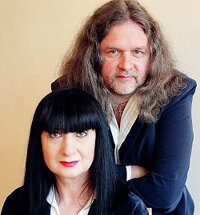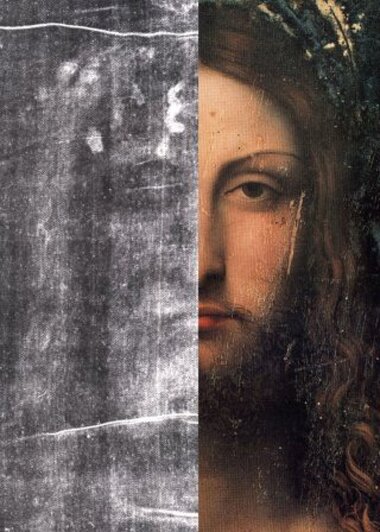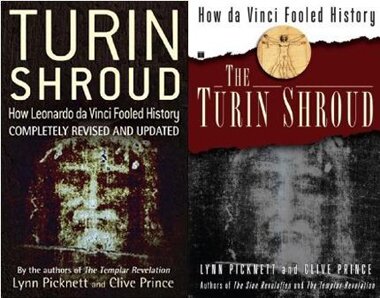
(c) Lynn Picknett and Clive Prince
You might not realise it but you’ve probably seen Lynn Picknett and Clive Prince before. They’re there as passengers on the double-decker bus taking Robert Langdon (played by Tom Hanks) to London’s Temple Church in the film adaptation of The Da Vinci Code, and their presence in the scene was no accident. Rather, it was an acknowledgement of that story’s debt to their research.
When Dan Brown was writing his best-selling novel, he drew heavily on ideas in Lynn and Clive’s 1997 book The Templar Revelation, which had offered interpretations of Jesus Christ, John the Baptist, and Mary Magdalene that were very different from those presented by the Roman Catholic Church. Unsurprisingly, publication of The Templar Revelation prompted an outcry from various quarters. It was, however, only one step along Lynn and Clive’s esoteric journey.
 The Templar Revelation had come about as they continued their research into the works of Leonardo da Vinci, in which they see hidden and heretical symbolism. That same research has now led them to announce a new discovery, one supporting their long-held and controversial belief that the Italian genius was responsible for what might be the greatest fraud of all time - namely, that he faked one of Christianity’s most holy relics.
The Templar Revelation had come about as they continued their research into the works of Leonardo da Vinci, in which they see hidden and heretical symbolism. That same research has now led them to announce a new discovery, one supporting their long-held and controversial belief that the Italian genius was responsible for what might be the greatest fraud of all time - namely, that he faked one of Christianity’s most holy relics.
I asked Lynn and Clive to tell me more.
For the benefit of readers unfamiliar with your books, could you briefly outline your theory regarding the connection between Leonardo da Vinci and the Turin Shroud?
 In our 1994 book Turin Shroud: In Whose Image?, revised in 2006 as Turin Shroud: How Leonardo da Vinci Fooled History, we argued that he faked the alleged holy relic - believed to be the actual burial cloth of Jesus, miraculously imprinted with his image and bearing his redemptive blood.
In our 1994 book Turin Shroud: In Whose Image?, revised in 2006 as Turin Shroud: How Leonardo da Vinci Fooled History, we argued that he faked the alleged holy relic - believed to be the actual burial cloth of Jesus, miraculously imprinted with his image and bearing his redemptive blood.
We also argued, based on intensive research, that he created the image using a basic form of photography - a camera obscura - which is why it has puzzled so many people for so long.
And to cap it all, we believe that he used his own face as the model for that of Christ. All of this was not only within his capabilities - he was known to experiment with camera obscuras, for example - but it also perfectly fits his mind-set.
We believe that Leonardo’s Shroud was first displayed in 1494 in a town very close to Milan (where he was working at the time) and replaced an earlier, cruder, and more obviously faked “Holy Shroud” which had been exhibited in France.
 An exhibition of Leonardo’s work has just opened at The National Gallery in London, and among the treasures being shown is his painting Christ as Salvator Mundi (Christ as the Saviour of the World), which dates from around 1499. It is this painting that you say presents "compelling new evidence" of a connection between Leonardo and the Shroud. What is this new evidence?
An exhibition of Leonardo’s work has just opened at The National Gallery in London, and among the treasures being shown is his painting Christ as Salvator Mundi (Christ as the Saviour of the World), which dates from around 1499. It is this painting that you say presents "compelling new evidence" of a connection between Leonardo and the Shroud. What is this new evidence?
As you can see from the YouTube video (below), the face of Leonardo’s Saviour of the World matches that of Shroudman to an astonishing degree. Given all the other evidence we present in our book to link him with the Shroud, the match between the two images is surely way beyond coincidence. We’ve tried to match the image to many other portraits, but none come anywhere near as close as this.
Watching your video, I can certainly see a resemblance between the Salvator Mundi face and the image on the Shroud, but are you suggesting that both are actually images of Leonardo? Could it not be that Leonardo simply based his painting of Christ on the Shroud image?
Either way, it shows Leonardo had an intimate knowledge of the Shroud of Turin, which is the most important thing as far as we’re concerned because our critics have always said there was no hard or documentary evidence to link the two. Now there is.
The bottom line is that if he’s the man on the Shroud, and he painted the Saviour of the World from it, then yes, both are images of himself.
We weren’t the first or the only people to notice the resemblance between Leonardo and the Shroud. Even some who still believe it is Jesus’ relic have independently mused on the similarity!
 The picture you paint (sorry!) of Leonardo is one that has provoked much controversy among art historians. Why do you think this is so?
The picture you paint (sorry!) of Leonardo is one that has provoked much controversy among art historians. Why do you think this is so?
Art historians tend to dismiss us because we’re not art historians, basically. And if we were talking about anyone other than Leonardo, they might have a point, but in his case there is a major difference.
The mistake art historians make is regarding him as just an artist. He was so much more than that in ways that Michelangelo and other big names of the day simply weren’t. Just look at his inventions - most obviously helicopters, but also sewing machines - and the enormous breadth of his interests and insights. In any case, it’s clear that Leonardo himself regarded his ability to paint amazing pictures as the least of his talents. And, more importantly, art historians routinely ignore what Leonardo’s own contemporaries always drew attention to - his playfulness, humour, love of jokes, conjuring, and illusions (at which he was highly accomplished).
Whoever faked the Shroud had to possess, to say the least, not only the mind of a genius, but also the attitude of a joker. And in order to fake Christ’s redemptive blood the hoaxer would have had to have no fear for his immortal soul. Leonardo was known to be at best an agnostic but - as our own research has shown - one could go further and describe him as a hard-core heretic.
In the light of your latest research, will you be revising your previous book on the Shroud, or do you have plans to bring out a new book?
We’re hoping there will be a revised and updated edition of our Shroud book early next year.

Thank you both very much!
To keep up with research by Lynn Picknett and Clive Prince, and to watch out for news of their revised book, visit their website.
Leonardo da Vinci’s painting, Christ as Salvator Mundi, is currently on display at The National Gallery in London.
All images courtesy of Lynn Picknett and Clive Prince.

